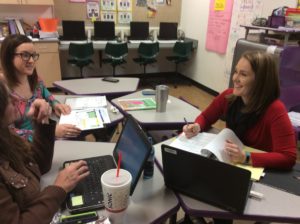By Melissa Wilbert, first published by Real Clear Education, December 20, 2016

When schools implement an Opportunity Culture®, one of the five principles they must follow calls for providing protected in-school time for planning, collaboration and development. Every teacher would agree that we need more time to plan. We also beg for more time with other teachers for collaboration because we all know the power in aligning our lessons.
But there just aren’t enough hours in the day! To add planning time with other teachers, we would have to subtract teaching time. Most schools committed to collaboration struggle with this, but my school turned it into a positive, using this as enrichment time for our students.
In our planning time, each multi-classroom leader led her teaching team in developing lesson plans aligned to the state standards, as well as providing professional development and setting a team goal for the week. For our initial Opportunity Culture® year, teaching teams (PLCs, or professional learning communities) got three additional hours of planning time a week. Previously, we had just 50 minutes of “conference time” together once a week to prep materials/hold parent meetings/plan/collaborate. At first we spread the three hours across two days, but soon found that the stop-start from one day to another really interrupted the flow of planning.
How could we make a three-hour block in one day benefit both us and students? Our PLC time backed up to the students’ hour-long “specials” times—physical education, music, or computers. So, after specials for the day, students went into what they started calling their “PLC rotations”—which were actually their enrichment periods—spending one hour in one rotation before switching to another. Over two weeks, then, with four groups of students in the grade level, students would have been to all four enrichment rotations, and we would have a weekly three-hour block just for collaborative planning, plus the 50 minutes another day for all our other team tasks.
To the students, enrichment time equaled instructional fun: They loved our planning days. When reviewing our daily schedule in the morning, they would cheer, “Yay! It’s PLC rotation day!”
How it works: One of our paraprofessionals takes a group to a computer lab, where the students work on one of the district-purchased educational websites. Meanwhile, our librarian sets up STEAM (science, technology, engineering, art, and math) activities around the library. The “reach associate” studying to become a teacher supervises a group of students rotating through reading stations while she works with small groups in remediation—a great place for students to practice reading fluency, phonics skills and writing. In the fourth rotation, students participate in science lessons that I plan, aligned to classroom instruction, working in the science lab with retired teachers who volunteer their time.
Science proved most popular: When going over the schedule in the morning, we would hear cheers for the science station. Kids always came back from science raving about the activity. It proved to be a useful incentive for one student who was having trouble, knowing he could not participate without good behavior during the day. And another student begged for his papers from the science lab for days, until I got them all back, reviewed and graded, from the retired teachers. He couldn’t wait to go home and show his parents!
And as a bonus, my students saw in action what it means to be “lifelong learners”: I explained to them how we teachers got together to plan the weeks’ activities and teach one another new things. When I would pick them back up after our planning block, they often asked what I learned in my PLC!
This all-hands team approach pulled the staff together and had the bonus of giving aspiring teachers a chance to gain valuable experience. One paraprofessional told me how she loved feeling like a genuine part of the grade-level team.
So now we had a greatly protected three-hour block of planning time, and we used every last minute. I created an agenda every week to focus on the upcoming state standards, collaboration on instructional strategies and a goal that the team would focus on next.
But I didn’t have to do all the work: This was powerful professional learning that let me turn more responsibility for planning over to the rest of the team as the year progressed, because their confidence and knowledge about how to plan grew dramatically.
And we saw the effects on our students. Increased interest in science was huge, and students’ reading improved through working with the reach associate, who used guided reading and tracked students’ progress in sight words and reading levels. Because all of our instructional paraprofessionals help cover the PLC rotations, they all felt invested with our kids.
We’ve kept the planning block this year, but added a paraprofessional to at least two of the rotations so that enough people know the routines and procedures to cover any absences.
And in using this all-hands approach, we reached beyond the two grades using an Opportunity Culture® team. All our grade-level teams loved this approach so much that they wanted to use it whether they were led by an MCL or not — so this year, they did!
Melissa Wilbert, an educator for nine years, is the multi-classroom leader for first- through third-grade reading at Moss Elementary in Big Spring, Texas.
